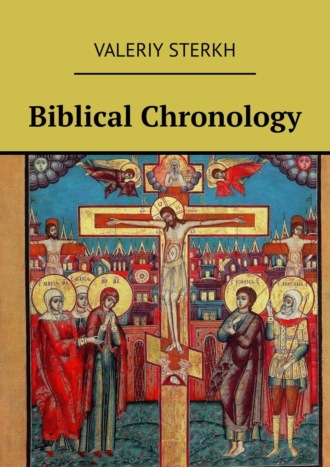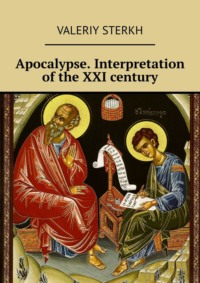
Полная версия
Biblical Chronology
For example, based on the Gauss formulas, Nisan 15 of the year 5775 in the Jewish calendar corresponds to March 22, 2015, in the Julian calendar. Now we can calculate JDN for this date (JDN =2457117). Consequently, Tisri 1 of the year 5776 corresponds to JDN=2457280. The remainder of division is 0. Therefore, the day is Monday. We have already determined that Nisan 15 of the year 5776 in the Jewish calendar (2016 NE) falls on Saturday. Using Table 3 (see above), we see that the year 5776 of the Jewish calendar is embolismic, that is, its duration is 385 days (an excessive year).
The procedure for converting a Julian day number (JDN) into a Julian calendar date is as follows:
1) c=JDN+32082.
2) d= [(4c+3) /1461].
3) e=c- [1461d/4].
4) m= [(5e+2) /153].
5) day=e- [(153m+2) /5] +1.
6) month=m+3—12* [m/10].
7) year=d-4800+ [m/10].
Where year is the year of NE; month is the number of the month; day is the day of the month; value in brackets is the integer part.
For example, let us convert the Julian day number JDN=2457280 (Tisri 1 of the year 5776 in the Jewish calendar) into a Julian calendar date:
1) c=2489362.
2) d=6815.
3) e=184.
4) m=6.
5) day=1.
6) month=9.
7) year=2015.
Consequently, Tisri 1 of the year 5776 in the Jewish calendar falls on September 1 2015 of the Julian calendar, or September 14 of the Gregorian calendar.
The Julian day and the Egyptian calendar
To convert a Jewish calendar date into a Julian calendar date, we should first find the the Julian day number:
JDN= (N-1) *365+ (M-1) *30+ (D-1) +1448638,
where “N” is the year of the Nabonassar era; “M” is the ordinal number of the Egyptian calendar month; “D” is the date of the month.
The calculation procedure of date is the same as the one described in the previous chapter.
Для For example, let us calculate the day of the Julian calendar corresponding to Pharmuthi 25 of the year 777 of the Nabonassar era.
Julian day number:
JDN= (777—1) *365+ (8—1) *30+ (25—1) +1448638=1732112.
Julian calendar date:
1) c=1764194.
2) d=4830.
3) e=37.
4) m=1.
5) day=7.
6) month=4.
7) year=30.
So, Pharmuthi 25 of the year 777 of the Nabonassar era falls on April 7th 30 NE.
Calculations simplified
Chronology calculations became so much easier now that we have computers. The above algorithms can be effectively implemented using popular computational programs or programming language scripts. Also, there are ready-to-use programs and online services designed specifically for calendar calculations; some of them are described in the Addendum.
Section 2. The Old Testament chronology
Speaking of the challenges of calculating dates in the era “from the foundation of the world”, or “from Adam” in Section 1, we didn’t mention one important reason for the lack of consensus regarding the biblical chronology. There are several versions of the Old Testament text (Jewish-Masoretic, Samaritan, Septuagint). For the most part, they are identical, but there are discrepancies which may affect chronology. Some passages contain significant chronological inconsistencies, so a natural question arises as to which dating is more accurate.
Eastern Orthodox Church regards the Septuagint as the canonical text of the Old Testament (The Septuagint comes from Latin “Interpretatio septuaginta seniorum” – “The translation of the seventy scholars”, for this reason, it is often referred to as LXX). The Septuagint is the translation of the Jewish Scripture into Greek completed at the initiative of Demetrius of Phalerum (350 – 283 BNE), the founder and head of the Library of Alexandria. Demetrius persuaded the Egyptian king Ptolemy II Philadelphus (308 – 245 BNE) to have the sacred books of the Jewish canon translated into Greek. Torah (the Pentateuch) was translated in the 3rd century BNE. The remaining Old Testament books were translated later – in the second and first centuries BNE. Some details regarding the process of translation for the Pentateuch are provided in the “Letter of Aristeas, the bodyguard of Philadelphus, to brother Philocrates”. This letter is cited, for example, by Philo of Alexandria (The Life of Moses, 2,6—7), by Josephus Flavius (Judean Antiquities, 12,1—2), in the Talmud (Megillah, 9), by Clement of Alexandria (Stromata, 1,22), by Irenaeus of Lyons (Against Heresies, 3,21,2), by Cyril of Jerusalem (Catechetical Lextures and Mystagogic Catecheses, 4.34), by Epiphanius of Cyprus (On the Seventy Interpreters), by Augustine the Blessed (The City of God, 18,42).
Below are listed some basic of the arguments in favor of the higher degree of accuracy of the Septuagint:
1) The translation of the Old Testament (Tanakh) into Greek, known as Septuagint, was completed in 3rd-1st centuries BNE and was based on the authentic Jewish text provided by the Jewish high priest. This is a sufficient warranty of the accuracy of the resulting text. One can argue about the nuances of meaning in the translated text, but it is hardly possible to assume that the dates and numbers could have been mistranslated.
2) The translators of the Septuagint were highly educated Jewish scribes. Those seventy two men continued to interact with each other as they were working on the Pentateuch (each Semitic tribe was represented by 6 scribes). One and the same passage was translated by different groups of scribes; then, the results were compared against each other. Thanks to this procedure, the probability of mistakes is very low.
3) The Septuagint was not created just for the Library of Alexandria. The Greek text was distributed far and wide. One copy was always at the disposal of the Jewish high priest:
“After he had arrived in Jerusalem, he [Egyptian king Ptolemy IV Philopator (c. 242 – 203 BNE)] offered sacrifice to the supreme God and made thank offerings and did what was fitting for the holy place. Then, upon entering the place and being impressed by its excellence and its beauty, he marveled at the good order of the temple, and conceived a desire to enter the sanctuary. When they said that this was not permitted, because not even members of their own nation were allowed to enter, not even all of the priests, but only the high priest who was pre-eminent over all – and he only once a year – the king was by no means persuaded. Even after the law had been read to him, he did not cease to maintain that he ought to enter, saying, ‘Even if those men are deprived of this honor, I ought not to be.’ And he inquired why, when he entered every other temple, no one there had stopped him” (3 Macc 1:9—12).
4) The Apostles and early Church Fathers quoted predominantly from the Greek text of the Old Testament. Luke, for example, follows the Septuagint (Gen 10:24; 11:12—13) when he gives his genealogy of Jesus by inserting Cainan (Lk 3:36) between Sala and Arphaxad. In the Masoretic text, Cainan is omitted.
5) From antiquity to the present day, the text of the Septuagint has been preserved almost intact, at least with regard to chronology.
6) The idea that the Jewish-Masoretic Tanakh is an infallible text of the original Old Testament is, obviously, erroneous. There’s enough evidence to the fact that the Jews had several versions of Tanakh with varying chronological data. For example, in the account from Adam through Noah, the Samaritan-Israelite Pentateuch is closer to the Jewish-Masoretic Tanakh, whereas in the partition from Arphaxad through Abraham it is closer to the chronology given in the Septuagint. This indicates an evolutionary accumulation of discrepancies over a long period of time.
7) Accumulation of errors in the Tanakh continued throughout the1st century NE. The Jewish historian Josephus Flavius in his famous book provides the chronological data in the Bible which contains further discrepancies (see Judean Antiquities).
8) The belief in the infallibility of the Jewish-Masoretic Tanakh faded away altogether after the ancient Jewish manuscripts of Qumran had been unearthed in 1947. These manuscripts reflect a whole range of chronological and textual traditions. Based on the paleographic data, external evidence, and the radiocarbon analysis, the main body of these manuscripts date between 250 BNE to 68 NE.
9) The finalization of chronology in the Jewish Tanakh occurred, most likely, around the 2nd century NE. This process must have been caused by historical circumstances, such as the destruction of the Jewish Temple, and the Roman invasion of Judea in 70 NE. Scattered throughout the world, the Jews must have been motivated to start thinking about preserving the uniformity of their religious texts. The fixed Jewish-Masoretic text of Tanakh was first translated into a foreign language in Syria at the end of the 2nd century NE. This translation was later called Peshitta. After some time, in the 4th century NE, the Jewish-Masoretic Tanakh was translated by into Latin by Jerome of Stridon; this translation was termed the Vulgate.
10) The fixed text of the Jewish-Masoretic Tanakh is not identical across various manuscripts and contains multiple discrepancies.
11) The much shorter chronology of the Jewish Tanakh contradicts the current data obtained through independent dating methods. For example, according to the Jewish tradition, the conquest of the Babylonian Empire by Cyrus II happened in 370 BNE (year 3390 from the foundation of the world in the Jewish calendar). But the scientific dating places this event in 539 BNE.
Based on the above considerations, it seems reasonable to use the dates and numbers of the Septuagint as the source for recreating the Old Testament chronology.
The brief research given below is not meant to demonstrate the whole range of the Old Testament datings. Its main purpose is to indicate the general duration of the described events. That’s why only key dates have been included. Let us first note that the period from the creation of the world to the beginning of the new era was 5550 years. So for the sake of convenience, the calculated dates are given in a twofold format: first, the dates from Adam, then the astronomical dates in NE (in parentheses; -5549 NE corresponds to 5550 BNE and so on).
1 (-5549). Creation of Adam and Eve
“So God created man in his own image, in the image of God created he him; male and female created he them… And the evening and the morning were the sixth day” (Gen 1:27, 31; compare Gen 2:7—25).
“And Adam called his wife’s name Eve; because she was the mother of all living” (Gen 3:20).
The tradition holds that the first man and woman, Adam and Eve, were created on the sixth days of the 1st year. It is believed that this day was Friday.
231 (-5319). The birth of Seth
“And Adam lived an 230 years, and begat a son in his own likeness, after his image; and called his name Seth” (Gen 5:3).
1+230=231
436 (-5114). The birth of Enos
“And Seth lived an 205 years, and begat Enos” (Gen 5:6).
231+205=436
626 (-4924). The birth of Cainan
“And Enos lived 190 years, and begat Cainan” (Gen 5:9).
436+190=626
796 (-4754). The birth of Mahalaleel
“And Cainan lived 170 years, and begat Mahalaleel” (Gen 5:12).
626+170=796
961 (-4589). The birth of Jared
“And Mahalaleel lived 165 years, and begat Jared” (Gen 5:15).
796+165=961
1123 (-4427). The birth of Enoch
“And Jared lived an 162 years, and he begat Enoch” (Gen 5:18).
961+162=1123
1288 (-4262). The birth of Methuselah
“And Enoch lived 165 years, and begat Methuselah” (Gen 5:21).
1123+165=1288
1475 (-4075). The birth of Lamech
“And Methuselah lived an 187 years, and begat Lamech” (Gen 5:25).
1288+187=1475
1663 (-3887). The birth of Noah
“And Lamech lived an 188 years, and begat a son: And he called his name Noah” (Gen 5:28—29).
1475+188=1663
2163 (-3387). The birth of Sim, Ham, and Japheth
“And Noah was 500 years old: and Noah begat Shem, Ham, and Japheth” (Gen 5:32).
1663+500=2163
2263 (-3287). The Great Flood
“And Noah was 600 years old when the flood of waters was upon the earth” (Gen 7:6).
The Flood happened 100 years after the birth of Sim, Ham and Japheth.
2163+100=2263
2265 (-3285). The birth of Arphaxad
“Shem was an hundred
The conjecture
2263+2=2265
2400 (-3150). The birth of Cainan
“And Arphaxad lived 135 years, and begat Cainan” (Gen 11:12).
2265+135=2400
2530 (-3020). The birth of Salah [Sala]
“And Cainan lived 130 years, and begat Salah” (Gen 11:12).
2400+130=2530
2660 (-2890). The birth of Eber
“And Salah lived 130 years, and begat Eber” (Gen 11:14).
2530+130=2660
2794 (-2756). The birth of Peleg
“And Eber lived 134 years, and begat Peleg” (Gen 11:16).
2660+134=2794
2924 (-2626). The birth of Reu
“And Peleg lived 130 years, and begat Reu” (Gen 11:18).
2794+130=2924
3056 (-2494). The birth of Serug
“And Reu lived 132 years, and begat Serug” (Gen 11:20).
2924+132=3056
3186 (-2364). The birth of Nahor
“And Serug lived 130 years, and begat Nahor” (Gen 11:22).
3056+130=3186
3265 (-2285). The birth of Terah
“And Nahor lived 79 years, and begat Terah” (Gen 11:24).
3186+79=3265
3335 (-2215). The birth of Abram, Nahor, and Haran
“And Terah lived 70 years, and begat Abram, Nahor, and Haran” (Gen 11:26).
3265+70=3335
3435 (-2115). The birth of Isaac
“And Abraham was an 100 years old, when his son Isaac was born unto him” (Gen 21:5).
3335+100=3435
3495 (-2055). The birth of Esau and Jacob
“And Isaac was 60 years old when she [Rebekah] bare them [Esau and Jacob]” (Gen 25:26).
3435+60=3495
3625 (-1925). The Jews move to Egypt
“And Pharaoh said unto Jacob, How old art thou? And Jacob said unto Pharaoh, The days of the years of my pilgrimage are an 130 years” (Gen 47:8—9).
3495+130=3625
4055 (-1495). The Exodus from Egypt
“Now the sojourning of the children of Israel, who dwelt in Egypt
Some translations contain the conjecture
However, the conjecture
3625+430=4055
4532 (-1018). The beginning of Solomon’s reign
“And it came to pass in the 480 year after the children of Israel were come out of the land of Egypt, in the 4 year of Solomon’s reign over Israel, in the month Zif, which is the second month, that he began to build the house of the LORD” (1 Kings 6:1).
There were 477 years between Exodus and the reign of Solomon.
4055+477=4532
4535 (-1015). The founding of the first Temple in Jerusalem
The construction of the Temple began 3 full years after, that is, in the fourth year of Solomon’s reign (see 1 Kings 6:1).
4532+3=4535
4572 (-978). The beginning of Rehoboam’s reign
“And the time that Solomon reigned in Jerusalem over all Israel was 40 years. And Solomon slept with his fathers, and was buried in the city of David his father: and Rehoboam his son reigned in his stead” (1 Kings 11:42—43).
37 years after the construction of the Temple began.
4535+37=4572
4589 (-961). The beginning of Abijam’s [Abijah’s] reign
“And Rehoboam the son of Solomon reigned in Judah. Rehoboam was forty and one years old when he began to reign, and he reigned 17 years in Jerusalem” (1 Kings 14:21).
“And Rehoboam slept with his fathers, and was buried with his fathers in the city of David. And his mother’s name was Naamah an Ammonitess. And Abijam his son reigned in his stead” (1 Kings 14:31).
4572+17=4589
4592 (-958). The beginning of Asa’s reign
“3 years reigned he [Abijam] in Jerusalem” (1 Kings 15:2).
“And Abijam slept with his fathers; and they buried him in the city of David: and Asa his son reigned in his stead” (1 Kings 15:8).
4589+3=4592
4633 (-917). The beginning of Jehoshaphat’s reign
“And 41 years reigned he [Asa] in Jerusalem” (1 Kings 15:10).
“And Asa slept with his fathers, and was buried with his fathers in the city of David his father: and Jehoshaphat his son reigned in his stead” (1 Kings 15:24).
4592+41=4633
4658 (-892). The beginning of Jehoram’s [Joram’s] reign
“And he [Jehoshaphat] reigned 25 years in Jerusalem” (1 Kings 22:42).
“And Jehoshaphat slept with his fathers, and was buried with his fathers in the city of David his father: and Jehoram his son reigned in his stead” (1 Kings 22:50).
4633+25=4658
4666 (-884). The beginning of Ahaziah’s reign
“And he [Jehoram] reigned 8 years in Jerusalem” (2 Kings 8:17).
“And Joram slept with his fathers, and was buried with his fathers in the city of David: and Ahaziah his son reigned in his stead” (2 Kings 8:24).
4658+8=4666
4667 (-883). The beginning of Athaliah’s [Hotholia’s] reign
“And he [Ahaziah] reigned 1 year in Jerusalem” (2 Kings 8:26).
“And when Athaliah the mother of Ahaziah saw that her son was dead, she arose and destroyed all the seed royal. But Jehosheba, the daughter of king Joram, sister of Ahaziah, took Joash the son of Ahaziah, and stole him from among the king’s sons which were slain; and they hid him, even him and his nurse, in the bedchamber from Athaliah, so that he was not slain. And he was with her hid in the house of the LORD six years. And Athaliah did reign over the land” (2 Kings 11:1—3).
4666+1=4667
4673 (-877). The beginning of Jehoash’s [Joash’s] reign
“And the seventh year Jehoiada sent and fetched the rulers over hundreds, with the captains and the guard, and brought them to him into the house of the LORD, and made a covenant with them, and took an oath of them in the house of the LORD, and shewed them the king’s son [Jehoash]” (2 Kings 11:4).
“And they slew Athaliah with the sword beside the king’s house. Seven years old was Jehoash when he began to reign” (2 Kings 11:20—21).
Jehoash began reigning after six full years, on the seventh year of Athaliah’s reign.
4667+6=4673
4713 (-837). The beginning of Amaziah’s [Amasia’s] reign
“And 40 years reigned he [Jehoash] in Jerusalem” (2 Kings 12:1).
“And he [Jehoash] died; and they buried him with his fathers in the city of David: and Amaziah his son reigned in his stead” (2 Kings 12:21).
4673+40=4713
4742 (-808). The beginning of Azariah’s reign
“He [Amaziah] was twenty and five years old when he began to reign, and reigned 29 years in Jerusalem” (2 Kings 14:2).
“And all the people of Judah took Azariah, which was sixteen years old, and made him king instead of his father Amaziah” (2 Kings 14:21).
4713+29=4742
4794 (-756). The beginning of Jotham’s reign
“And he [Azariah] reigned 52 years in Jerusalem” (2 Kings 15:2).
“So Azariah slept with his fathers; and they buried him with his fathers in the city of David: and Jotham his son reigned in his stead” (2 Kings 15:7).
4742+52=4794
4810 (-740). The beginning of Ahaz’s reign
“And he [Jotham] reigned 16 years in Jerusalem” (2 Kings 15:33).
“And Jotham slept with his fathers, and was buried with his fathers in the city of David his father: and Ahaz his son reigned in his stead” (2 Kings 15:38).
4794+16=4810
4826 (-724). The beginning of Hezekiah’s reign
“And [Ahaz] reigned 16 years in Jerusalem” (2 Kings 16:2).
“And Ahaz slept with his fathers, and was buried with his fathers in the city of David: and Hezekiah his son reigned in his stead” (2 Kings 16:20).
4810+16=4826
4855 (-695). The beginning of Manasseh’s reign
“And he [Hezekiah] reigned 29 years in Jerusalem” (2 Kings 18:2).
“And Hezekiah slept with his fathers: and Manasseh his son reigned in his stead” (2 Kings 20:21).
4826+29=4855
4910 (-640). The beginning of Amon’s [Ammon’s] reign
“Manasseh was twelve years old when he began to reign, and reigned fifty
“And he [Manasseh] reigned 55 years in Jerusalem” (2 Chron 33:1).
“And Manasseh slept with his fathers, and was buried in the garden of his own house, in the garden of Uzza: and Amon his son reigned in his stead” (2 Kings 21:18).
The conjecture
4855+55=4910
4912 (-638). The beginning of Josiah’s reign
“And he [Amon] reigned 2 years in Jerusalem” (2 Kings 21:19).
“And he [Amon] was buried in his sepulchre in the garden of Uzza: and Josiah his son reigned in his stead” (2 Kings 21:26).
4910+2=4912
4943 (-607). The battle of Megiddo, the reign of Jehoahaz, captivity in Egypt, the beginning of the reign of Jehoiakim
“And he [Josiah] reigned 31 years in Jerusalem” (2 Kings 22:1).
“In his days Pharaohnechoh king of Egypt went up against the king of Assyria to the river Euphrates: and king Josiah went against him; and he slew him at Megiddo, when he had seen him. And his servants carried him in a chariot dead from Megiddo, and brought him to Jerusalem, and buried him in his own sepulchre. And the people of the land took Jehoahaz the son of Josiah, and anointed him, and made him king in his father’s stead” (2 Kings 23:29—30).
“And he [Jehoahaz] reigned 3 months in Jerusalem” (2 Kings 23:31).
“And Pharaohnechoh made Eliakim the son of Josiah king in the room of Josiah his father, and turned his name to Jehoiakim, and took Jehoahaz away: and he came to Egypt, and died there” (2 Kings 23:34).
4912+31=4943
4954 (-596). The reign of Jehoiachin [Jeconiah], the Babylonian captivity, the beginning of the reign of Zedekiah






